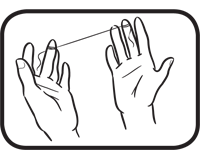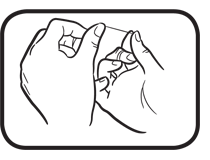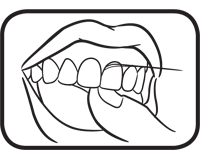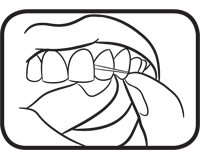Do kids need to floss?
Yes, flossing should be part of everyone’s dental hygiene routine! Typically when toddlers have two teeth touching, it’s a good time to add flossing to the daily brushing routine. Here’s some pro flossing tips from doctors Rubin and Sentelle… who are not only pediatric dentists, but dads too!
Teaching Children to Floss
Flossing Picks vs. Traditional Floss
“We frequently get asked, ‘Do my kids need to floss?’“, says Dr. Rubin. “Many young kiddos have large spaces between their teeth. Yes, you still need to brush! Yes, you still need to floss! It’s actually easier to floss if there’s space between the teeth, but don’t forget about the back teeth. Many times those teeth don’t have any space between them and that’s where food gets caught. To floss you can either use handy, disposable floss sticks that come in all shapes, colors and sizes, or you can also use traditional string floss that you wrap around your fingers.”
Dr. Sentelle says, “I prefer the floss with the handles better, especially if parents are trying to floss for their kids … it keeps less of your hand out of their mouth. And for little mouths that’s important to help keep those teeth nice and healthy!” Dr. Rubin laughingly adds, “and you have a free hand to help wrangle your kid while you’re flossing the teeth at the same time!”
“Overall the floss picks work well”, says Dr. Rubin. “Plus kids can choose the favorite color they like. It’s always good to give your kids a choice because they feel like they’re more involved if you give them a choice versus just making them do it.”
Step-by-step Flossing Guide
The most important thing about flossing is to do it! As long as you do a thorough job of cleaning between the teeth, it doesn’t matter when. Pick a time of day when you and your child can devote a couple extra minutes to the tooth brushing routine. Sometimes kids are too tired at the end of the day and may be more open to practice flossing first thing in the morning, or even after lunch. As we mentioned before, start a flossing routine as soon as your toddler has two teeth that touch. Because cleaning between teeth demands more manual dexterity, parents usually have to assist, or follow up, to make sure young children do a thorough job. Usually around age 10 or 11 children are able to handle flossing on their own. Until then, flossing with the pre-threaded, easy-to-grip floss picks might be the best option.
The American Dental Association provides this helpful step-by-step flossing guide that you can download, print and tape to the bathroom mirror to assist in teaching your children. These “How to Floss” steps are also outlined below:

Use about 18 inches of floss wound around each of your middle fingers. The opposite middle finger will take up the floss as it becomes dirty.

Hold the floss tightly between the thumbs and forefingers and gently insert it between the teeth.

Curve the floss into a “C” shape against the side of the tooth.

Rub the floss gently up and down, keeping it pressed against the tooth. Don’t jerk or snap the floss.

Floss all your teeth. Don’t forget to floss behind your back teeth. Once you’re finished, throw the floss away.
Brushing only cleans about 70% of the surface area of teeth, leaving the cracks and spaces between teeth uncleaned. Flossing helps remove food particles, plaque, and bacteria to get teeth 100% clean!
While we like to encourage recycling and reusing… string floss and floss picks are not meant for that purpose! Reusing a used piece of floss won’t be as effective and could leave bacteria behind in your mouth. Therefore, do not reuse floss or a floss stick over and over again! Also do not use unconventional tools to remove food between teeth, as they can actually harm the teeth! Only use traditional flossing tools like dental picks, string floss, tiny brushes that reach between the teeth, and water flossers. You may have to try different options until you find the one that works best for your child. The most important thing is to establish a routine and floss your child’s teeth every day. Find a time that works for you and your child, and stick to it!
Got more questions? We're here to help!
If you have any questions about how to teach your child to floss, or what types of flossing products might work best for your child, please call (214) 618-5200 during our office hours and our team will be happy to answer questions or book an appointment.
👉 Before you arrive for an appointment, please read our New Office Procedures and complete our COVID-19 Screening Form. Also review these procedures with your child(ren), so they are prepared too.
